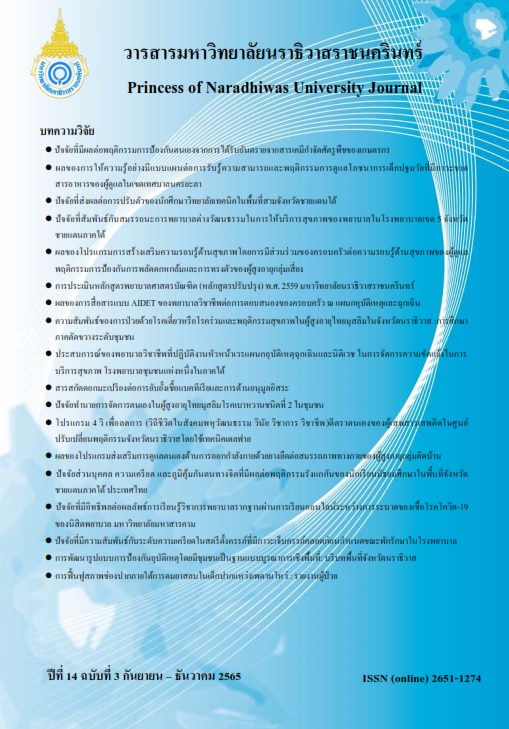Cynometra cauliflora Flower Extract on Antibacterial and Antioxidant Activity
Keywords:
MRSA 142, Cynometra cauliflora, Antibacterial, Antioxidant, Phenolic compoundAbstract
Nowadays, vegetables, fruits, and local herbs are popular for testing their antimicrobial and antioxidant properties. The purpose of this research was to study the effect of Cynometra cauliflora (C. cauliflora) flower extract on antibacterial and antioxidant activities. Agar well diffusion method, DPPH assay, and Folin-Ciocalteu method were used to determine the antibacterial activity, to study the antioxidant property, and to identify phenolic quantification, respectively. The results of this study showed that the extract of C. cauliflora flower has antibacterial effect against Staphylococcus aureus, Micrococcus luteus and Methicilin-Resistant Staphylococcus aureus with the inhibitory sites were 21.00±0.17, 25.00±0.00 and 26.00±0.15 mm, respectively. Minimum inhibitory concentration and minimum bactericidal concentration were 18.75 mg/mL and 300.00 mg/mL, respectively. In addition, the C. cauliflora flower extract showed anti-oxidant activity with an IC50 value was 0.11 μg/mL, while vitamin C had an IC50 of 312.62 μg/mL. This study also demonstrated that C. cauliflora flower extract contains 4.45 μg GAE/g fresh weight of total phenolic compounds.
References
Ado, M.A., Abas, F., Mohammed, A.S., & Ghazali, H.M. (2013). Anti- and pro-lipase activity of selected medicinal, herbal and aquatic plants, and structure elucidation of an anti-lipase compound. Molecules, 18(146), 51-69.
Atchana, S. (2018). The Study of Diversity and Local Wisdom in Medicinal Plants Usage for Thai Traditional Medicine Knowledge: A Case Study in Muang District, Ratchaburi Province. Department of Thai Traditional Medicine College of Muay Thai Studies and Thai Traditional Medicine Chom Bueng Rajabhat University, (in Thai).
Aziz, A.F., & Iqbal, M. (2013). Antioxidant activity and phytochemical composition of Cynometra cauliflora. Journal of Experimental and Integrative Medicine, 3, 337-341.
Khoo, H.E., Azlan, A., Kong, K.W., & Ismail, A. (2016). Phytochemicals and medicinal properties of indigenous tropical fruits with potential for commercial development. Evidence-Based Complementary and Alternative Medicine, 1, 1-20.
Meesup, P., & Buachard, S. (2018). Efficiency of plant extracts against Staphylococus aureus and Escherichia coli. Agricultural Science Journal, 49(2), (suppl.), 485-488.
Mostafa, A.A., Al-Askar, A.A., Almaary, K.S., Dawoud. T.M., Sholkamy, E.N., & Bakri, M.M. (2018). Antimicrobail activity of some plant extracts against bacterial strains causing food poisoning diseases. Saudi Jourmal of Biological Science, 25, 361-366.
Nachakanok, M., & Anong, S. (2019). Phenolic Contents and Antioxidant Activities of Mulberry Leaf Tea and Water Soluble Mulberry Leaf Tea Powder. Thai Journal of Science and Technology, 9(2), 230-242.
Somsap, O.-A., Piboonpol, G., Payanglee, K., & Daengrot, C. (2019). Antibacterial and Antioxidant Activity of Nam-Nam Fruit Extract. Princess of Naradhiwas University Journal, 11(2), 156-167.
Yuto, T., Ketsin, T., Anantasan, P., Siltrakool, B., Kangwanrattanakul, K., & Phanudulkitti, C. (2020). Consumers’ Awareness, Expectation, and Behaviors related to Antibiotic Use of Consumers in Community Pharmacies in Saensuk Municipality, Chonburi Province. The Public Health Journal of Burapha University, 15(2), 62-73
Valle Jr, D.L., Andrade, J.I., Puzon, J.J., Cabrera, E.C., & Rivera, W.L. (2015). Antibacterial activities of ethanol extracts of Philippine medicinal plants against multidrug-resistant bacteria. Asian Pacific Journal of Tropical Biomedicine, 5(7), 532-540.
Yanisa, L. (2015). Anti-bacterial activity from mangosteen rind and gac crude extract for printing textile. Burapha University: Cholburi, (in Thai).
Additional Files
Published
How to Cite
Issue
Section
License
Copyright (c) 2022 Princess of Naradhiwas University Journal

This work is licensed under a Creative Commons Attribution-NonCommercial-NoDerivatives 4.0 International License.




